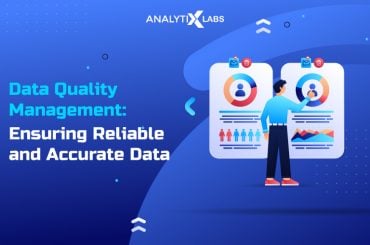Equipment and systems are now smart, connecting several devices and services to generate data for analysis and decision-making. The two prime technologies at play are IoT and Big Data.
In this article, you will learn what these two technologies are, how they are related and interact, what role big data plays in IoT, and the various examples and benefits of using IoT and big data analytics together.
Let’s start with understanding the two technologies, starting with big data.
What is Big Data?
Big Data is a phrase used in the technology domain to refer to vast amounts of data. Such datasets can come in various shapes and forms, i.e., they can be structured, semi-structured, and unstructured and constitute multiple data types.
The idea behind big data is that it can hold a lot of information and, when processed properly, can provide valuable information.
The primary objective for a company using big data is to improve its leadership and systems responsiveness. This can increase productivity, reduce costs, and help understand customer behavior and market trends.
There are specific characteristics of big data known as the four V’s.
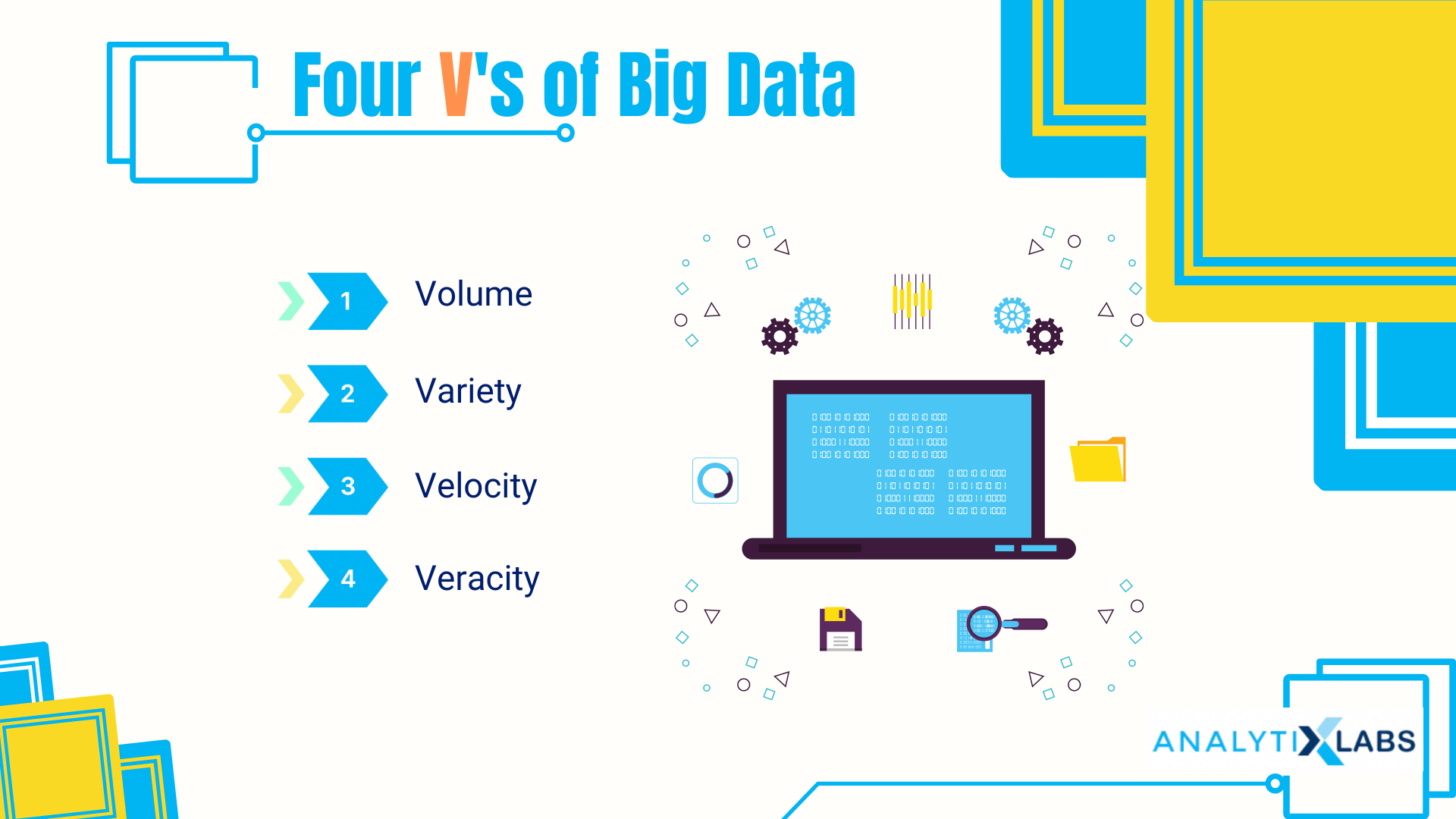
- Volume : A large amount of data from various sources
- Velocity : High rate of frequency at which data is generated and processed
- Variety : Several data types are available and transferred across the systems, such as audio, video, text, data frames, etc.
- Veracity : High-quality information that, through the use of big data tools, can be separated and brought to the surface to provide unique insights
Related read: Understanding Data Veracity in Big Data
Big data and big data analytics are closely related. Big data analytics refers to using various tools on big data to process and organize it to gain valuable insights.
Also read: Big Data Technologies That Drive Our World
What is IoT?
The second piece of the puzzle is IoT, i.e., Internet of Things.
IoT refers to integrating and connecting numerous physical objects and systems through shared networks.
To make this integration possible, multiple sensors of various types are embedded in these objects and systems to create an ecosystem where information is collected and shared from various sources.
Therefore an IoT device, commonly called a ‘smart‘ device, can refer to any device with sensors that have the ability to transmit and receive information.
To be precise, there are three main parts or categories to an IoT device-
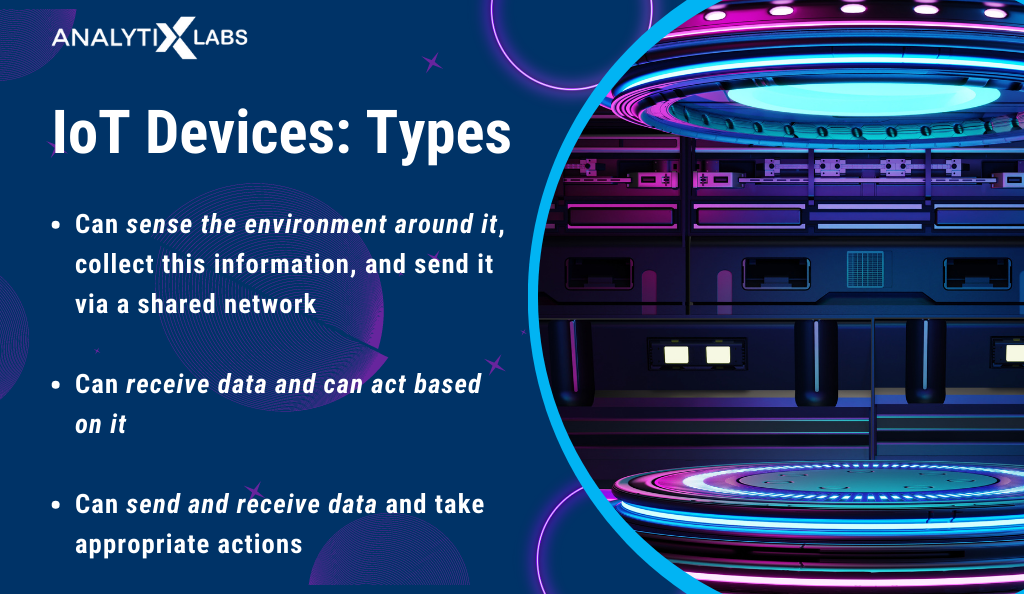
- It is a device that can sense the environment around it, collect this information, and send it via a shared network—for example, motion sensors, soil moisture sensors, etc.
- A device that can receive data and can act based on it. For example, smart printers that receive the document and print it or modern car keys that automatically open doors based on their proximity to the car
- A device that can perform both the above tasks, i.e., can send and receive data and take appropriate actions. An example is a smart irrigation system where a soil moisture sensor transfers data to an irrigation system via the internet that waters the crops.
Today IoT devices can be anything from heavy industrial equipment to simple wearables like watches. To further understand these devices, you first need to comprehend the relationship between big data and IoT.
Also read: AI in Big Data
Relationship between Big Data and IoT
Big data and IoT share a unique relationship. While they were developed independently and have significant differences in their functioning, there is also considerable overlap between them.
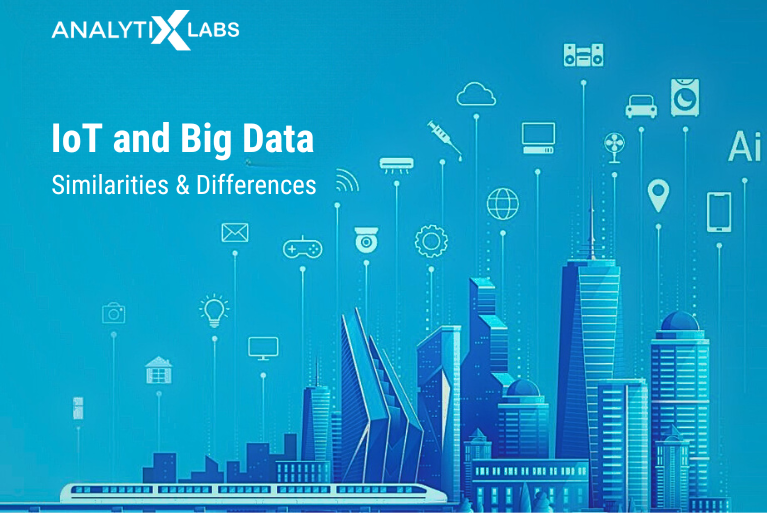
Let’s first understand how these two technologies are common.
IoT and Big Data: Similarities
The idea behind IoT is that devices in the network are connected via the internet and made aware of their surroundings through sensors. However, the data generated through these sensors can be considered big data.
This is mainly because several pieces of equipment can be connected to a network at any given time and generate a large amount of data at a very high rate. The data generated from IoT, i.e., big data, then need to be compiled and stored to make sense of it and identify meaningful patterns. This is where big data analytics get involved.
Also read: Data Analytics in IoT: A Beginners’ Guide
Big Data and IoT: Differences
The two technologies, however, are significantly different:
IoT’s goal is to run analytics in real-time to support quick decision-making. This isn’t easy with big data analytics, where data is typically set aside and then analyzed.
While this approach may help track consumer habits, it’s not valid for self-driving cars.
Therefore IoT devices are increasingly embracing edge data processing. Here the latency of the data transfer is reduced, and the smart devices perform some data processing locally to produce immediate results for decision-making.
Therefore while the two technologies are different, they complement each other as the data generated from IoT is considered big data, and big data analytics can be used to increase the effectiveness of IoT devices. However, understanding their relationship now requires you to inspect how these two technologies work together.
How do IoT and Big Data Work Together?
As clear from the above discussion, there is a symbiotic relationship between IoT and Big Data. However, to understand how they interact in real-time, you need to focus mainly on the four steps involved in the workflow of IoT and Big data working together.
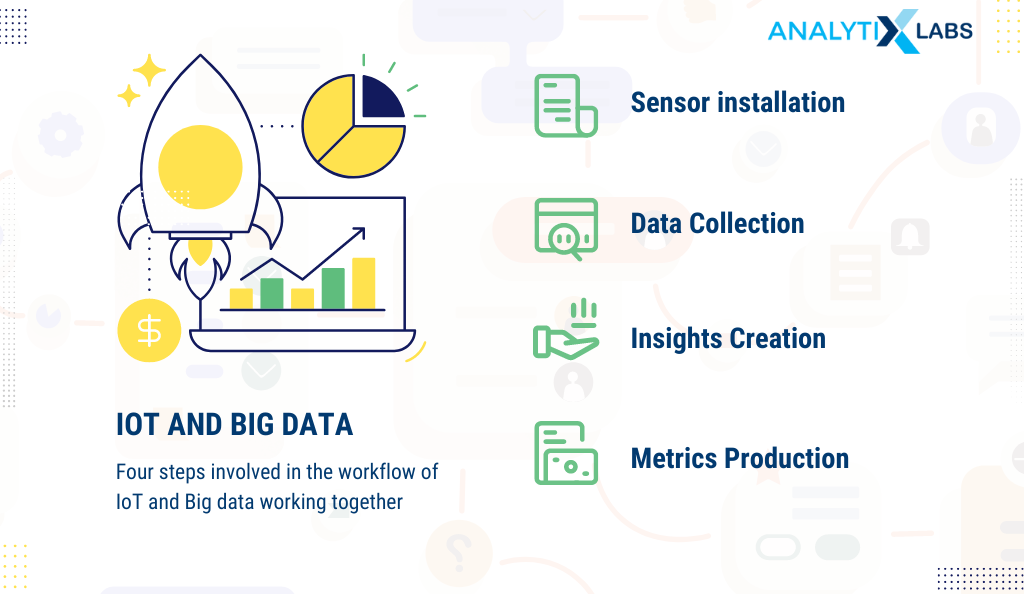
- Sensor Installation: Companies install sensors on various devices to collect and transmit data.
- Data Collection: Huge amount of data is generated by the sensor-embedded devices and system that is high in volume, velocity, variety, and veracity.
- Insights Creation: Big data analytics tools find patterns in IoT-generated data.
- Metrics Production: From the analysis, various actionable metrics are provided to the users that can be modified based on user settings, scheduling, metadata, etc.
If the relationship and interaction between IoT and big data are clear to you, then the next thing to understand is how big data plays a vital role in the larger scheme of things for the IoT.
Role of Big Data in IoT
IoT could be self-sufficient if it had the technology to handle its generated data. However, data handling in IoT is enabled by big data analytics. Big data plays a crucial role in the IoT ecosystem in four sequential steps.
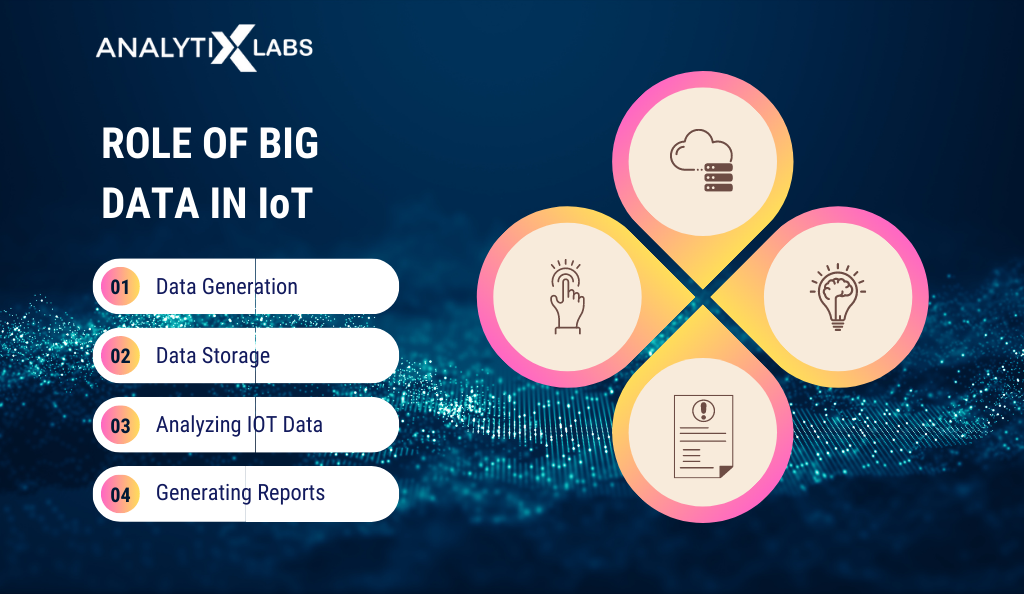
- Data Generation: The speed, volume, and variety with which IoT generates data get big data involved, and here the big data tools for collecting such data come into play.
- Data Storage: Big data databases play a crucial role in storing IoT-generated data.
- Analyzing IoT Data: Data handling in IoT is crucial, and tools like Spark and Hadoop are used to analyze complex IoT data.
- Generating Reports: Dashboards and other reports are created using other visualization tools.
Given big data’s significant role in IoT, it’s not the case that IoT doesn’t impact big data. Let’s now discuss the impact these techniques have on each other.
How Do Big Data and IoT Impact Each Other?
The impact of these technologies on each other can be defined in the following three ways.
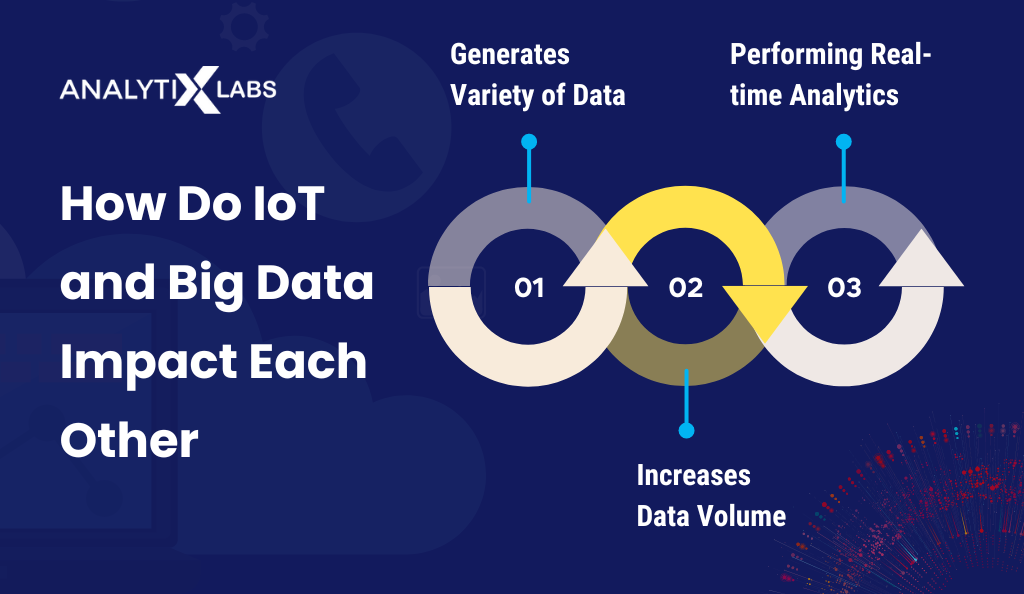 aww
aww
- Generates Variety of Data: A significant impact of IoT on big data is the varied kind of data it generates. Variety is a crucial aspect of big data. IoT sensors generate data in all shapes and forms, from images and audio to logs and other semi-structured and structured data.
- Increases Data Volume: Another impact of IoT on Big Data is the large volumes of data it generates, making big data availability easy.
- Performing Real-time Analytics: A significant impact of big data in IoT is that while traditionally, big data analytics required data to be first set aside and stored for it to be analyzed, today, with the advancement in certain big data technologies, it is possible to provide some immediate results by performing real-time analytics.
Now if you have understood these two technologies of big data and IoT and have comprehended how they are related, interact, and impact each other, then let’s look at a few examples to understand how these two technologies are transforming various industries and domains.
Big Data and IoT: Transforming Industries and Domains
Today, almost every industry or domain has been affected by big data and IoT. While there can be hundreds of examples, a few of the most prominent examples are the following-
-
City Infrastructure
Barcelona in Spain is a unique example of the use of big data and IoT not by an industry or domain but by a city. The city administration has provided city-wide wifi used by the numerous parking meters to provide real-time updates to the residents regarding the available parking spaces, with the payment of parking charges done digitally.
-
Energy Power Management
Smart electric meters are being increasingly used to collect consumption data. Power companies can use this information to reduce leakages, increase efficiency, and decrease public utility costs.
-
Health
The health industry has been one of the primary beneficiaries of the emergence of IoT and big data. Through these technologies, it’s now possible to monitor patients remotely and better manage the inventory and human resources such as medicines, equipment, and medical staff.
-
Communication and Entertainemnt
Due to IoT, multi-device content delivery is possible, leading to the rise of smart TVs, VR systems, and game consoles.
-
Manufacturing
Production monitoring and equipment maintenance have been the major areas where IoT has played a crucial role, as it allows manufacturing companies to schedule repairs and manage their inventory in a better manner.
-
Autonomous Vehicles and Robotics
The face of IoT is generally found in the automotive industry. The emergence of self-driving cars through IoT-generated data has made the use of IoT popular.
-
Retail
The retail industry has used IoT and big data analytics to enhance customer satisfaction and resolve inventory issues by personalizing the in-store experience and deploying smart shelves that use sensors to assess product availability and for better product placement.
The examples discussed so far are in no way exhaustive, as there are many other sectors where the combined use of IoT and big data have had a significant impact. These industries include-
- Transport Industry
- Supply Chain Management
- Sport
- Aviation
- Virtual Assistants
- Banking
- Education
- Agriculture
- Military
- Public Sector
As so many sectors are involved with big data and IoT, it is no surprise that many companies are working with these technologies. In this next section, you will learn the various benefits companies gain from using these two technologies.
How are IoT and Big Data Together Beneficial for Companies?
A McKinsey study shows IoT technology’s economic impact will be around 4 to 11 trillion dollars by 2025. It is mainly because of the large number of areas where the combined use of IoT and big data will have an impact. Here is a list of a few of these areas that will be transformed due to IoT and big data-
- operations management and predictive maintenance in factories and manufacturing units
- resource management, traffic control, health, and public safety in cities
- monitoring and managing illness in human health
- payout optimization, customer relationship, self-checkout in retail
- autonomous driving, navigation, and routing in transport
- equipment maintenance, human safety in work sites
- safety, security, automation, and energy management in homes
Given there are so many operations getting affected by the use of IoT and big data, there must be some real benefits that these two technologies provide. The most important benefits are the following-
-
Decision Making
Decisions can make or break any business, and IoT allows the management to make an informed decision. The information generated through IoT is in real-time and much more practical and tangible once big data analytics is performed.
This allows the business leadership to monitor operations, making decisions as and when required. For example, based on the products that have been interacted with, a business can know if its marketing campaign has been beneficial.
In contrast, they can be alerted if there is a sudden drop in customer behavior regarding particular products. Thus, IoT and big data allow quick and much more informed decision-making.
-
Supply Chain Management
Supply chain disruption has been the talk of the town since the covid-19 outbreak and the Russia-Ukraine conflict. IoT and big data analytics can be crucial here as supply chain management is a hugely complex task involving many stakeholders and technologies working together.
Through IoT, people, processes, departments, companies, and various devices can be connected, allowing the flow of live intel to the concerned people. The decision-makers can be proactive and data-driven in their activities through added visualization.
-
Risk Monitoring
Accidents and other disasters can be highly detrimental to any company’s financial health and reputation. It is, however, through IoT that the internal system of a business can be made smart, allowing companies to assess the probability of various adverse events.
This can enable companies to get alerted of potential risks on time so that they can react before a major disaster occurs. The IoT systems in these scenarios can work passively, and once any threshold is crossed, the concerned individuals can be alerted.
-
Knowledge of Trends
Every company and individual’s dream is to know the future, as it can allow them to make smart decisions to increase their chances of survival. A significant benefit of IoT and big data analytics is that it enables a business to have a much more informed idea about future trends.
By adding sensors to various machinery, their performance can be monitored, and how they will perform in the future can be predicted. Similarly, IoT can gather much more information about customer behavior and product sale, allowing companies to predict future trends.
-
ROI
An overall impact of IoT and big data analytics is that they can dramatically increase a company’s return on investment. The increase in ROI is a byproduct of various other benefits of IoT and big data analytics, i.e., increase in efficiency, reduction of cost, better decision-making, customer retention, and lastly, better quality of information for performing any data-backed task.
This is why companies are rapidly making their operations and equipment ‘smart’ by integrating them with IoT and big data.
To further understand how big data and IoT have benefited companies, let’s look at specific companies and how they have implemented big data analytics in IoT to enhance their capabilities.
How Companies have implemented Big Data Analysis and IoT?
-
United Parcel Services
United Parcel Services, a global shipping company, has been using big data and IoT to reduce cost, increase efficiency and become more ecologically friendly. UPS has been collecting sensor data by monitoring their vehicles’ speed, mileage, engine health, number of stops, etc.
The sensors on these vehicles capture around 200 data points daily, with the number of vehicles under operation being around 80,000. The extensive data generated through these sensors allows UPS to track daily operations and identify ways to make them run more efficiently.
UPS has utilized big data analytics in IoT to optimize delivery routes through their On-Road Integrated Optimization and Navigation (ORION) project. Here the idea is to utilize the various data collected through deliveries, such as the thousands of address data points, to optimize route planning.
-
Virgin Atlantic
Virgin Atlantic, a British airline, has adopted IoT and big data to predict the maintenance of aircraft and the various parts on board and improve fuel efficiency and overall flight quality.
They are achieving this by connecting their Boeing 787 and cargo devices through the internet, generating large volumes of data. The company seems to have understood the role of big data in IoT.
It thus has been creating predictive models using the half-terra bytes of data that each flight produces to achieve higher efficiency and effectiveness.
-
John Deere
The agriculture industry has been one of the prime adopters of IoT and big data and has greatly benefited from it. Therefore it’s no surprise that the leader of large agriculture equipment manufacturers has also decided to integrate their devices through IoT.
John Deere has increasingly been adding sensors to their equipment that capture information such as wind speed, humidity, rainfall level, leaf wetness, air, and soil temperature.
This information is then provided to the farmers over wireless connections. They then use it to identify when plants reach appropriate moisture levels, allowing them to make better irrigation decisions.
-
TempuTech
Another company that has significantly impacted the agricultural industry is TempuTech which provides connected systems for the betterment of the logistics aspect of the industry. Grain storage is a crucial aspect of the farming industry, and this company, through the use of IoT and big data, allows users to monitor and enable optimal grain storage.
The company also allows users to reduce potential risks in the various systems involved in this activity. This is done, for example, by looking for broken bearings or belts in grain elevators and other similar devices, monitoring temperature and moisture levels in grain bins, allowing users to set a fan and other aeration settings, etc.
-
Disney World Magic Band
A great example of the role of big data in IoT is the magic band created by the famous amusement park- Disney World. The magic band is a wearable wristband that, through the attached sensors, allows vacationers to navigate the park with ease.
It eases the check-in process to the hotel, buying lunch, reserving spots in the park, etc. The visitor movement data collected through these sensors allow Disney to make their operations more efficient, allowing them better manage and employ their staff, accommodate more guests, regulate the inventory of shops and restaurants, etc. All of this helps the company to increase its revenue and customer satisfaction.
-
Alex and Ani
Particular business heavily relies on what products they can recommend and showcase to their customers, and jewelry store is one of them. Alex and Ani have therefore employed IoT and big data in their stores that track the movement of customers. They can better organize and display products by analyzing the store’s customer movement ‘heatmap’.
-
Clermont-Ferrand University Hospital
As mentioned previously, the one industry that has highly benefited from IoT and big data and the use of data science, in general, is the healthcare industry. Today you can find various examples of hospitals that have understood the role of big data in IoT, consequently increasing the effectiveness of their diagnosis and treatment.
The example here is the Clermont-Ferrabd University Hospital in France, which has partnered with Microsft and Capsule Technologies to enable the use of IoT and big data in their hospital.
The system built by the hospital allows them to collect data from various medical devices enabling the management to maximize the occupancy and provide more real-time information to the medical professionals making their jobs effective and easy.
-
BC Hydro
BC Hydro, a Canadian electric utility company, has been using IoT and big data to convert their electric meters into smart meters. The company’s customers can now track their energy usage and manage their consumption by looking at the trends.
While IoT and big data have increased customer satisfaction, the company has increased its profit as devices have identified electricity theft and potential power outages. Using such smart devices has also made them more competitive, as now it’s possible for them to provide their services at a remotely lower cost.
-
PTC
PTC, an American software company, has equipped manufacturers with IoT and big data analytics. The companies can, in turn, have a holistic view of their daily operations, allowing them to increase revenue and production.
Thus, companies like PTC have based themselves on providing services and products related to IoT, which has allowed them to survive and grow in the highly competitive world of software companies
-
GE Digital
GE Digital is another company that has benefited from providing smart systems to factories.
They offer applications that allow for automated tasks and provide constant manufacturing updates. Their products have made the business more cost-effective and their processes more streamlined without sacrificing product quality.
As you can see, there are numerous examples of the domains and companies benefitting from big data and IoT. As the technology improves, IoT and big data will only expand, and more industries and companies will adopt this technology to stay relevant and profitable.
Conclusion
Given the benefits of the combined use of big data and IoT, there is a lot of potential for both these technologies. The biggest hindrance companies and organizations face in adopting these technologies is the steep cost of the initial investment. However, the long-term savings and benefits outweigh the initial investment.
Also, due to rapid technological advancement, using IoT and big data analytics is a matter of profitability and survival. The future looks bright for those working in the big data and IoT industry, and companies seem to have decided on these technologies.
FAQs
- Is big data and IoT the same?
Big data and IoT are not the same, as they are two different technologies. While IoT refers to using sensors for connecting and integrating systems and devices, big data refers to the large volumes of data often produced by such smart systems and devices.
- What are the advantages of big data and IoT?
Companies and organizations can become more profitable and efficient using big data and IoT. These technologies enable better decision-making, reduce costs, and assess future trends and risks.
- Why is big data an issue for IoT?
There are several challenges because of which big data becomes an issue for IoT. These challenges include the following-
- Data management and storage issues
Data generated from IoT devices is high in velocity, making storing and managing such data difficult. Also, the data can often be disorganized and unstructured, which requires building frameworks to collect, store and handle such data.
- Data Visualization issues
As mentioned above, the large amount of data generated from IoT is unstructured, which makes it challenging to visualize and relay the information through dashboards.
- Privacy
The biggest issue for IoT is that the data generated can be so massive that it can hold a lot of information which can often be private and confidential. This makes using personal information for developing products and services questionable and unethical. The issue of privacy makes the adoption of IoT by the masses difficult.
As more companies plan to adopt and implement big data and IoT together, there will be a huge demand for individuals with knowledge of these technologies.
I hope this article helped you expand your understanding of the relationship and interaction between these two technologies and how they can benefit companies. If you want to know more about IoT, big data, or similar technologies, then do write back to us.

![Iot and Big Data: Understanding The Symbiotic Relationship [With Examples and Use Cases] IoT and Big Data cover](https://www.analytixlabs.co.in/blog/wp-content/uploads/2023/07/IoT-and-Big-Data-cover.png)



